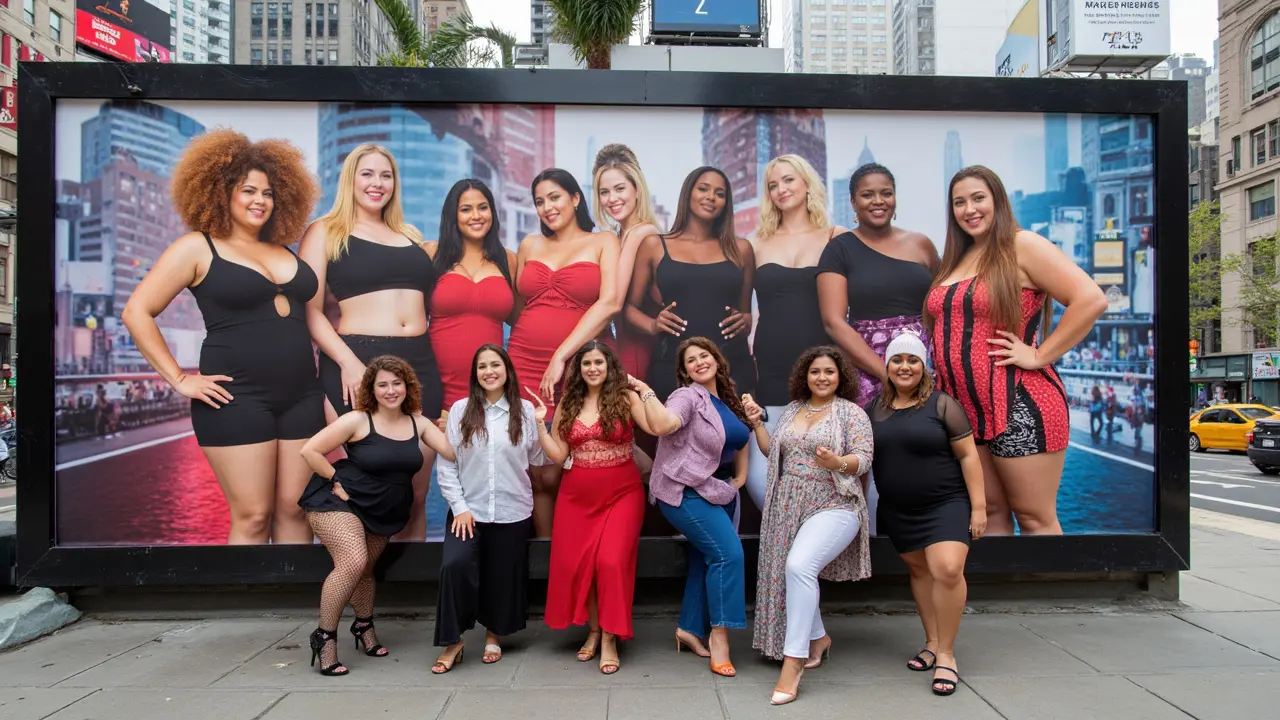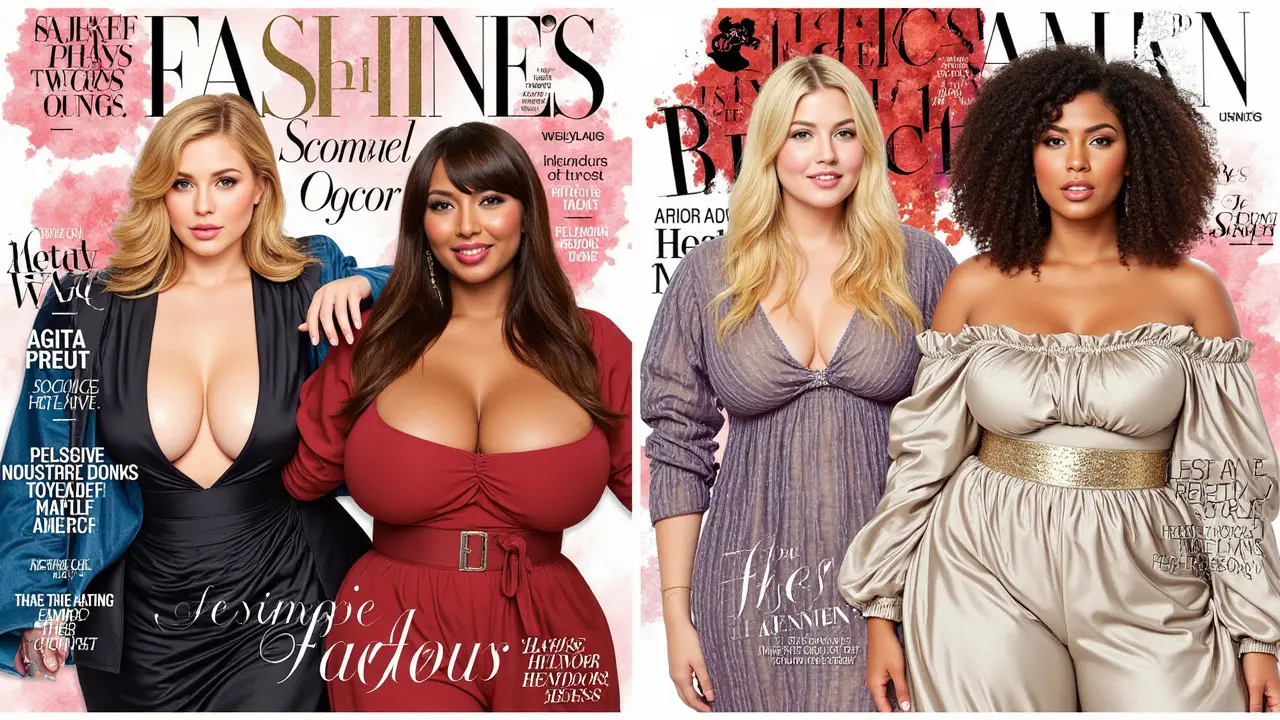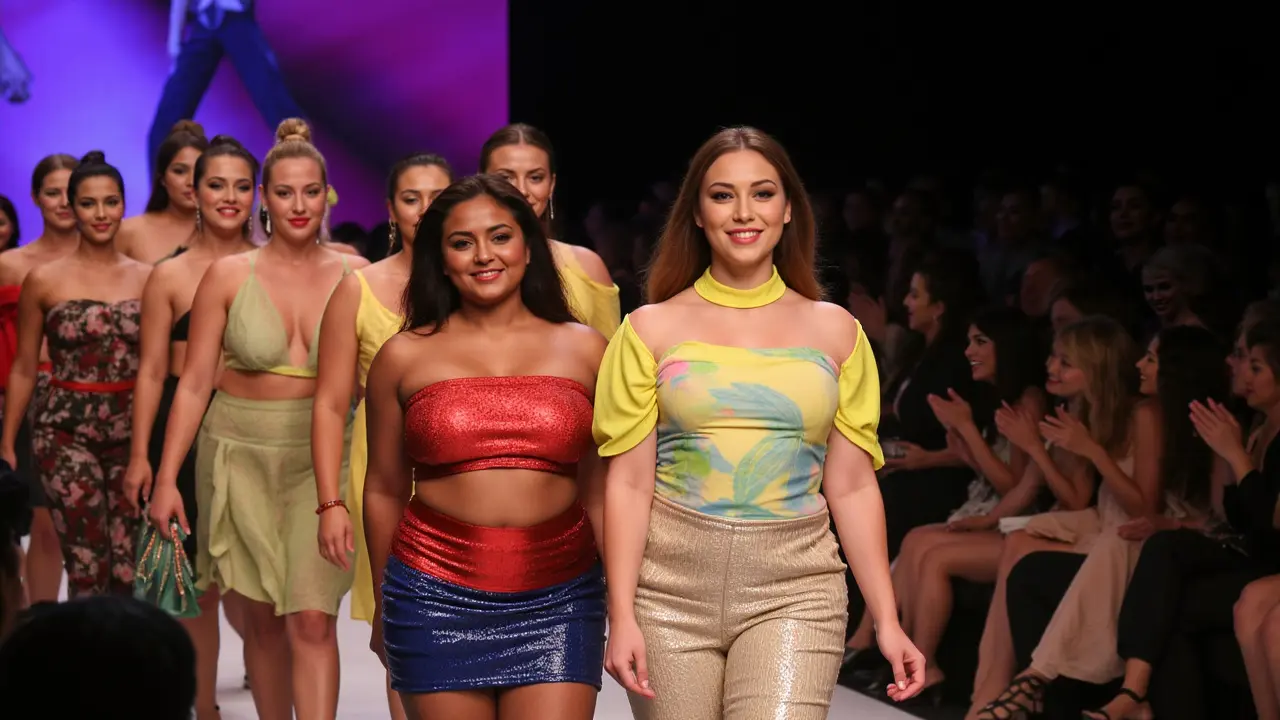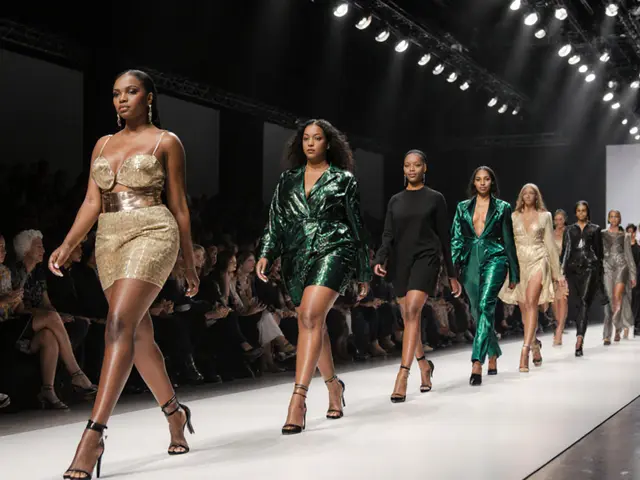Forget everything that magazines told you in the early 2000s—there’s a fresh face (and figure!) owning the runways and billboards now. Curvy models aren’t just a “trend”; they’re rewriting the rules of beauty, ditching one-size-fits-all in favor of something everyone can feel connected to. Think about the first time you saw someone like Ashley Graham on a Vogue cover, or scrolled through Instagram and found a confident, curvy woman rocking a slip dress, just being authentically herself. That split second of recognition? It’s changing how we see ourselves—not to mention the entire fashion industry. Real bodies, relatable stories, and genuine smiles are in; cookie-cutter standards are out. If you’ve ever felt your worth didn’t fit into sample-size jeans, you’re not alone. Let’s talk about how curvy models aren’t just modeling clothes; they’re modeling self-acceptance, reshaping culture, and proving that beauty isn’t about size, it’s about being unapologetically you.
Breaking Stereotypes: The Influence of Curvy Models on Modern Beauty Standards
Once upon a not-so-distant time, most clothing brands only visualized fashion on lean silhouettes, leaving a huge chunk of real-life women feeling alienated. Fast-forward to right now: plus-size and curvy models, like Paloma Elsesser and Precious Lee, are regularly landing magazine covers, starring in high-fashion campaigns, and even strutting down runways once considered off-limits. It’s not just token representation, either. In 2024, research from The Fashion Spot revealed that 21% of all runway models in major fashion weeks had a body type above a size 8—up from just 2% in 2016. That’s not a silent shift; it’s a revolution, and people are taking notice.
Curvy models shatter stereotypes by embracing features that mainstream media used to Photoshop away. Stretch marks? Cellulite? Thicker thighs? Instead of hiding these, many models celebrate them, sharing untouched photos and behind-the-scenes confessions. This shift isn’t just about the models themselves. Fans—especially younger audiences who’ve grown up scrolling through filtered social feeds—are craving authenticity. You’ll see it in TikToks where creators show “Instagram vs. Reality,” or in comments full of gratitude for models who post honest, unfiltered snapshots. Suddenly, bodies that looked like yours or your friend’s are not just acceptable—they’re celebrated.
Marketing plays a huge role here. Business giants like Savage X Fenty and Aerie feature a diverse line-up of curvy talent, refusing to digitally retouch scars or bumpy skin. These moves aren’t just feel-good social gestures. According to a 2023 McKinsey report, brands that used body-diverse marketing saw a 32% boost in customer engagement compared to brands with strictly traditional models. Ads featuring models across a spectrum of body shapes aren’t only profitable—they’re proof that representation sells. As a result, more companies are ditching the “one-size-fits-some” mantra and welcoming all shapes and sizes on billboards and social media feeds. If you grew up thinking beauty came with a number, seeing your body reflected in the media is a seismic validation. That’s how change gets real—one campaign, one post, one jaw-dropping runway moment at a time.
The ripple effect spreads far beyond fashion magazines. TV, movies, even reality competition shows are recognizing the power of diverse casting. When a curvy model smashes the glass ceiling in one industry, it often inspires others to follow. Last year, for instance, Miss Universe Denmark hailed a plus-size contestant among its finalists—a move cheered worldwide for its inclusivity. Every time a curvy model claims their spotlight, the old rules take another hit. The message is simple but radical: You deserve to shine, just as you are.
| Year | Percentage of Curvy Models in Runways |
|---|---|
| 2016 | 2% |
| 2019 | 8% |
| 2022 | 15% |
| 2024 | 21% |
Numbers like these tell a story—and it’s one of hope and progress. Your feed, your ads, the styles in your favorite stores: they look different now, because curvy models demanded the spotlight and kept it. That’s not just good business, it’s good for everyone’s self-image.

Living and Loving Out Loud: The Everyday Impact of Body Positivity
It’s easy to look at a glamorous photo of a curvy model and smile, but the real change kicks in when you and I start to see ourselves with that same confidence. Body positivity isn’t some slogan stuck to a mirror—it seeps into your daily life, your choices, and your closet. Let’s be real: how many times have you felt like skipping that beach party or squeezing into shapewear just to blend in? Seeing people who look like you in mainstream media gives you permission to ditch the “shoulds.” You start buying the swimsuit with bright patterns, not hiding behind a black cover-up. You show up. According to a 2024 YouGov survey, nearly 52% of women aged 18-34 said that seeing diverse bodies in media made them feel better about their own appearance.
But let’s talk about the practical side too. Curvy models have pushed brands to create clothes that actually fit and flatter, instead of just sizing up thin-girl patterns—a move that’s sparked an entire wave of plus-size designers and trendsetters. Look up brands like Eloquii, Universal Standard, and Ganni’s extended line—these aren’t “token plus” sections, these are full, dedicated collections. You’ll find cool street style, chic work outfits, and even high-drama red carpet looks. Fashion isn’t about hiding curves anymore—it’s about celebrating them in bold colors and tailored fits. The days of apologizing for “problem areas” have passed. Fashion weeks in cities like London and New York now include size-inclusive shows as a main event, not a novelty.
Of course, confidence isn’t always a switch you can flip. Maybe you’re still wary of trying out a bold trend, or you worry that others will judge if you don’t blend in. Here’s where social media comes in. Platforms like Instagram and TikTok are full of curvy creators sharing outfit ideas, beauty hacks, and candid talks about body image struggles. Community matters. Swap tips with people who get what you’re going through (like how to find jeans that truly fit hips and thighs, or how to layer a slip dress for every body type), and you’ll see how body positivity is contagious. The more you see models—real people—rocking the looks you want to try, the easier it is to give it a whirl yourself.
Let’s not forget about mental health. Experts at the National Eating Disorders Association say that increasing visibility of diverse body types helps reduce shame, anxiety, and body dysmorphia, especially among teens. A study published in the Journal of Health Psychology, July 2023 issue, found that women exposed to body-diverse media were 38% less likely to report feelings of body dissatisfaction. That’s real progress!
Here are a few easy ways to channel that curvy model energy in your daily life:
- Follow body-positive creators and hashtag feeds for daily inspiration.
- Unfollow accounts that make you feel less-than—you control your feed.
- Say yes to activities you love, not the ones you think you "should" do.
- Try new trends or bold looks, even if you feel nervous. Confidence grows with action.
- Celebrate compliments; don’t brush them off. You earned that praise.
- Connect with local communities or online forums for support and style swapping.
Body positivity isn’t about “fixing” yourself; it’s about seeing beauty where it’s always been. The message these models are sending is simple: You’re enough, you’re worthy—and you don’t have to change to feel great in your skin.

Fashion, Fame, and the Future: Curvy Models Reshaping the Industry
Fashion’s once-rigid rules are finally bending, and curvy models are at the forefront of that shift. Names like Ashley Graham, Tess Holliday, and Jill Kortleve are no longer just making cameos; they’re headlining campaigns, winning awards, and landing contracts with brands that used to say “sorry, no plus-size.” In February 2025, for instance, Graham became the first curvy model to host the CFDA Awards, with her opening remarks centering around joy, diversity, and inclusion. That was a night of pure electricity for the industry—but it also sent ripples through every viewer who never saw themselves reflected in such glamorous spaces before.
Agencies now scout for talent of all shapes, colors, and sizes. IMG, Wilhelmina, and even elite European agencies are expanding their rosters, knowing that clients want real, relatable talent—not unrealistic ideals. The lineup isn’t just larger; it’s also more global. Models from Brazil to Germany to Kenya are stealing the show in homegrown and international ads, uniting people around the world through a shared message: style isn’t determined by size.
Fashion magazines, once locked in an endless cycle of cover clones, are looking different too. Vogue, Elle, and Glamour are spotlighting curvy models both on covers and in feature spreads. The British edition of Vogue, in September 2024, did a massive 12-page shoot with models ranging from sizes 6 to 20, dressed by luxury designers who previously only produced sample sizes. That editorial sent shockwaves—curvy models were finally showcased as aspirational, not just “realistic.” Style columnists called that issue a “watershed moment.”
The red carpet glow-up is another major scene. This year’s Cannes Film Festival featured curvy actresses and models taking center stage, instead of being shunted to the sidelines. Designers jostled to dress them, knowing millions would see and share every sparkling look. When Lizzo wowed at the Grammys in a custom Balmain gown, or when Precious Lee closed the Versace show in Milan, it wasn’t just a win for one model—it inspired thousands of fans to see themselves as worthy of their own spotlight.
Future models are noticing too. Open calls for curvy and plus-size talent are at an all-time high, and modeling schools are overhauling their curriculums to ditch the “thin-is-in” mindset. If you ever dreamed about modeling but thought you didn’t “fit the mold,” now’s the time to step up. Agencies want individuality—birthmarks, curves, freckles and all.
But this journey isn’t free from pushback. Some corners of the industry (and sadly, internet comment sections) still cling to distorted notions of health or “marketability.” But with every barrier-breaking moment—from sports covers to Victoria’s Secret’s total relaunch—curvy models are proving resilience is their secret weapon. Support keeps growing. Even after years of progress, every bold new shoot or viral runway moment chips away at old, limiting beliefs.
Want to punch your own ticket to self-celebration? Here are a few tips inspired by the women leading this movement:
- Don’t wait for permission. The only runway that matters is the one you walk every day.
- Experiment: Try out statement pieces, colorful prints, or body-hugging styles just for fun.
- Seek out brands and influencers that foster real talk and community—not just sales.
- Use your voice. Every time you speak out or post a pic, you’re rewriting someone’s beauty standards—including your own.
As curvy models keep pushing the envelope and showing up in every corner of the media, the takeaway couldn’t be clearer: This isn’t a fleeting phase. Body positivity is here to stay, and its champions—on magazine covers, city streets, and your social media feed—are only just getting started. Ready to see what comes next? Step into the spotlight. This is your moment too.






Teresa Bulhoes
I absolutely love seeing curvy models gaining the spotlight in fashion. It’s such a breath of fresh air compared to the usual cookie-cutter standard of beauty we’ve been fed for decades. There’s something truly empowering about watching brands embrace real bodies and celebrate diversity in all its glorious forms.
Not only does this shift encourage self-love, but it also challenges narrow norms that have caused so many to feel invisible or inadequate. I think it’s more than just aesthetics; it’s about dignity and representation too. When you see yourself reflected boldly and beautifully, it fosters a sense of belonging and confidence.
It’s thrilling to imagine a future where fashion isn’t a source of anxiety but a celebration of who we genuinely are. Can’t wait to see this movement grow even stronger. 💖
Chrissy Brown
YES! This is such an exciting time for body positivity. I get hyped every time I see a campaign showcasing curvy models rocking those fierce looks. 🌟 It sends a huge message that fashion is for EVERYONE, not just one type of body.
It's like a ripple effect—more diversity in media means more people feeling understood and appreciated. It’s beyond style; it’s about shifting mindsets and breaking down old biases. And honestly, it’s inspiring for younger generations who desperately need those fresh role models.
Can anyone else feel the energy of change? It’s palpable and so necessary!
Matthew Whitehead
Really appreciate this movement gaining traction. It’s about time fashion caught up with reality. People’s bodies naturally come in all shapes and sizes, and embracing that diversity is not just good ethics but also enriches the industry creatively.
Body positivity helps us rethink who we admire and why. It encourages self-respect and promotes healthier societal views. This trend will hopefully reduce stigma and encourage inclusivity well beyond fashion.
Thanks for shedding light on this important evolution. Let’s keep pushing for more diverse representation everywhere.
Leonie Holly
honestly this new wave of curvy models is kind of long overdue but def welcome. it's not just about looking good but about how this shifts perceptions deeply rooted in society. bodies of all kinds rly deserve representation tho sometimes i wonder if this is just a trend or something that will stick around and truly influence culture. sometimes fashion seems to pick up things superficially.
also i think the focus should be on making spaces safe, kind & empowering for those who haven't been the center in the past. but it’s good to see changes happening slowly.
Marcia Chrisyolita
The increasing prevalence of curvaceous models in the contemporary fashion industry represents a paradigmatic shift that goes beyond mere aesthetic inclusivity. It embodies a complex interplay between evolving consumerist expectations and the necessary recalibration of social constructs surrounding corporeal norms.
This trend transcends simplistic marketing ploys; it is an ideological reconstitution demanding public recognition of corporeal heterogeneity as normative rather than anomalous. However, the industry must remain vigilant against tokenism or superficial pandering which risks nullifying the transformative potential of this movement.
Meticulous analysis of advertising semiotics reveals that genuine embracement of body positivity necessitates systemic change, not only in representation but also in labor practices and consumer engagement strategies.
Chuck V
This topic hits so many chords for me! The idea that fashion is finally becoming a playground that reflects the true varieties of human bodies is not just uplifting but revolutionary. It's a profound push against the homogenizing forces that have long dictated who gets to be seen and celebrated.
I remember growing up where the fashion world was predominantly narrow in its idealization, almost borderline exclusionary. Now, watching curvy models take center stage is like witnessing a cultural renaissance in real-time.
It shows that the industries can pivot, that audiences crave authenticity, and that there’s substantial beauty in diversity. This shift elevates everyone, from consumers to creators, by making fashion more humane and approachable. It’s about telling stories that resonate universally, breaking barriers that have restricted creativity for way too long.
Dale Zebick
It's encouraging to see the fashion scene embracing various body types more openly. This more balanced representation can contribute to a healthier self-image across the board, reducing the pressure to conform to unrealistic standards.
By including curvy models in campaigns and runway shows, brands are sending a message that beauty is multifaceted. It's a step forward in cultivating a more accepting culture where individuality is respected rather than suppressed.
Still, there’s work ahead to ensure this inclusivity is not performative but integrated deeply into fashion’s core values.
Dan Packer
I think this trend is truly heartening, especially considering how many people previously felt excluded from mainstream fashion due to their body size or shape. When brands showcase curvy models, it sends a message of acceptance and compassion that is powerful.
It also encourages people to embrace their bodies and reject harmful stereotypes linked to self-worth. Representation matters — it shapes how we see ourselves and each other.
More than just appearances, this movement could foster a much-needed culture of kindness and realistic expectations in fashion and society alike.
Bonnie Searcy Squire
While it might seem commendable that curvy models are more visible, there's an underlying danger of this becoming just another manipulative trend by the fashion industry. The whole body positivity movement has been co-opted and commercialized to sell products rather than enact genuine systemic change.
One must be cautious and question whether this inclusiveness is truly sincere or merely strategic marketing designed to placate critics while maintaining the status quo. The industry’s historical complicity in narrow beauty ideals makes this skepticism warranted.
Don’t be fooled by glossy ads; real progress demands more than surface-level representation.